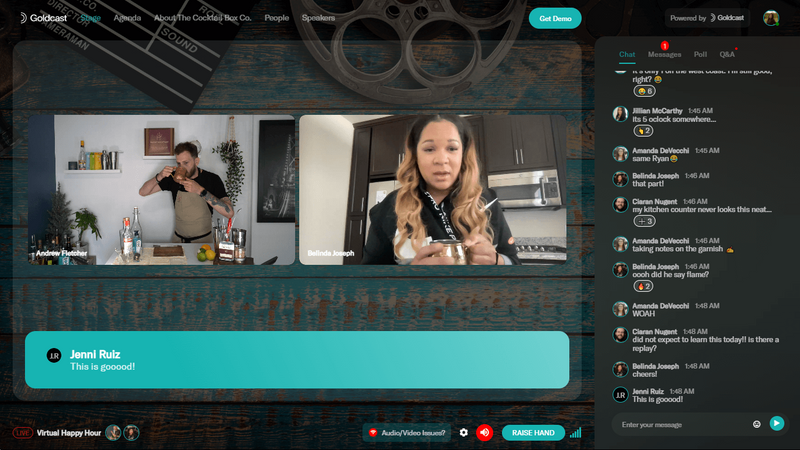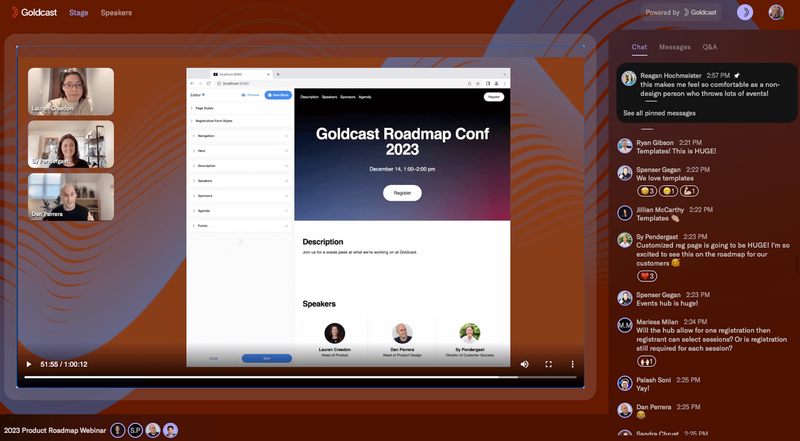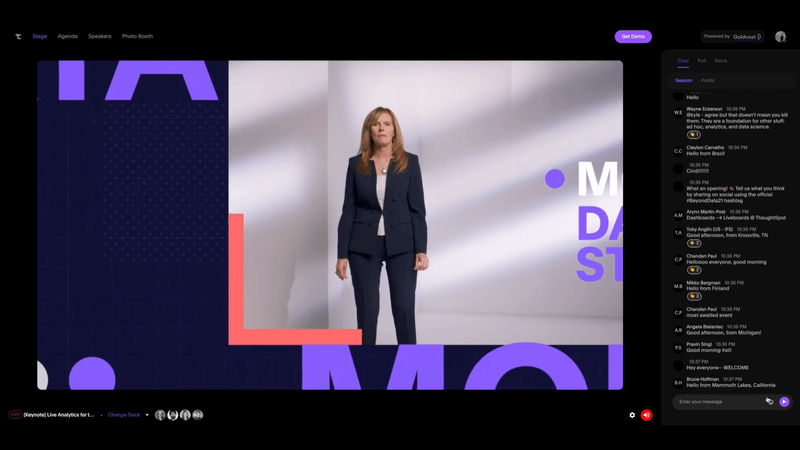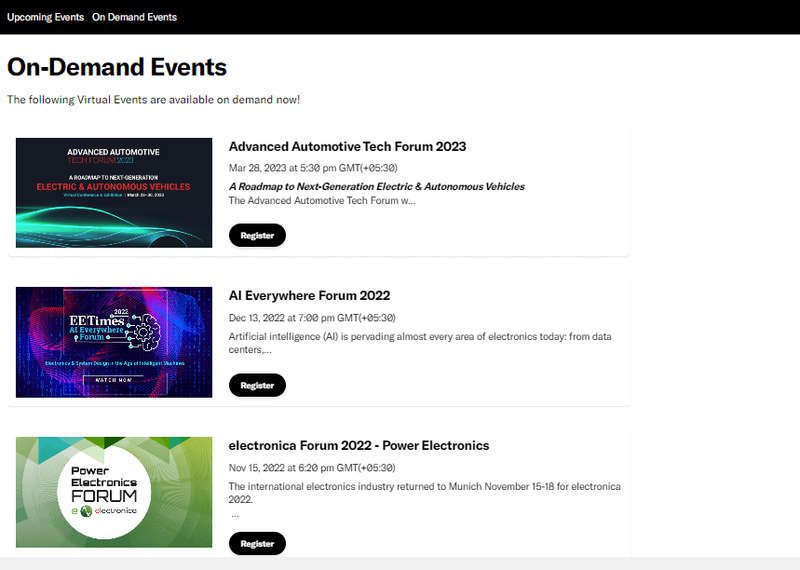Lucky 13: Types of Virtual Events to Boost Your Marketing Results

Maximize Your Marketing ROI
Join 10,000 other marketers already getting the best tips on running engaging events that boost pipeline and create raving fans.
Before digital events were a thing, businesses had basically one option. Get your brand out there in front of hundreds of prospects on the expo floor and hope it moves the needle on your goals. Events were hard to scale and even tougher to measure.
Today it’s a different story. 🙌🏻
Digital events now play a central role in every high-impact marketing strategy. They help you save time and money, and can be easily scaled to drive increased brand awareness and revenue.
But first you need to choose the right type of virtual events to make it happen.
Top 13 types of virtual events
- Digital field events
- Virtual trade shows
- Virtual expos
- Virtual conferences
- Virtual awards
- Virtual happy hours
- Virtual holiday parties
- Town halls
- Sales kickoffs
- Job fairs
- Community events
- Customer events
- On-demand events
What’s the difference between a virtual event and a webinar?
A virtual event is an event that is conducted online instead of in-person at a physical event venue. Like an in-person event, virtual events have multiple sessions, often including networking opportunities.
A webinar on the other hand, is like a seminar that is conducted online instead of in-person. It typically features one single session, does not include multiple presentations or content offerings, and has few or no networking opportunities.
While the exact definition of a virtual event can vary based on your organization’s goals and strategy, the main difference between virtual events and webinars is that a virtual event offers multiple sessions, while a webinar is a single-track event.
If you’re looking to uplevel your webinars, don’t miss our complete roundup of the most powerful webinar formats for increasing attendees.
13 different types of virtual events to set your brand apart
The number 13 might be unlucky for some. But when it comes to figuring out what type of virtual event is going to boost your results and revenue, having 13 choices is pretty awesome.
But before we get started, it’s worth noting that there is some overlap between the various types of events you can choose from. The best type of virtual event (or combination of virtual event types) is always going to vary best on your target audience, marketing goals, team structure, and more. And that’s ok.
What’s important is that you choose the right event formats for you and your attendees. So without further ado, let’s dive in!
1. Digital field events
A digital field event is a form of experiential marketing that places face-to-face relationship building at the forefront. These events are a favorite among account-based marketing (ABM) pros as a way to reach larger audiences of qualified prospects, then use event data to measure and replicate their events in different audience segments or “fields”.
Digital field events follow a similar format as their in-person counterparts. They are typically intimate gatherings with a group of highly targeted prospects who are all linked via their industry, needs, or challenges.
The only difference is that digital events take place in a fully or partially remote environment, rather than the proverbial ‘field’.
Whether your digital event is in-person, virtual, or hybrid, the ultimate aim is to accelerate pipeline growth.
For Commvault CMO, Isabelle Guis, the perfect digital field event meets prospects and customers online. For her, this means hosting one large digital event, supplemented with smaller, regionalized roadshows.
2.Virtual trade shows
Like their physical counterparts, virtual trade shows aim to build intrigue, interest, and excitement around a product or brand by giving the audience a deep, firsthand experience via live keynotes, breakouts, sponsor booths, Q&As and networking.
In-person trade shows are notoriously heavy on logistics and budget. Given both the time and financial investment required, many companies are dropping the large-scale, multi-day trade shows of old in favor of a more flexible and convenient virtual format.
Greg Spenser, Marketing Events Lead at Oyster, is quick to point out that traditional trade shows are a “ton of work.” 😅
He and his team are doubling down on virtual events as a more measurable and cost-effective alternative. With the right platform, you can easily replicate the presentations, booths, and networking opportunities typically found at a trade show.
3.Virtual expos
Expos are all about creating an immersive experience that takes attendees on a journey through a topic, challenge, or theme—often in the hope of presenting them with a solution at the end of it.
In-person expos are usually packed with booths, salespeople, and folks handing out fliers directing attendees your way.
At a virtual exhibition, you can replicate that level of interaction with virtual networking and engagement options to increase attendee activity, dedicated booths and rooms for live demos and sales conversations, and a full resource center including information packs, presentations, and other virtual takeaways.
The aim of an exhibition is usually to drive awareness, as opposed to landing the sale there and then. Which means your virtual event branding needs to be a major consideration. Be sure to make it memorable. You don't want to miss any opportunity to position your brand center stage.
4.Virtual conferences
‘Conference’ comes from the Latin ‘conferre’, which means ‘to bring together’. And virtual conferences do exactly that—they bring together industry pros to discuss everything from news and trending topics to major product shifts and industry developments.
The term virtual conferences is sometimes used synonymously with ‘virtual summits’. With a formalized agenda, a few high-profile speakers, and a ton of networking activities, virtual conferences are one of the most flexible event types out there and can be approached in many different ways.
For example, the goal of Onspring’s three-day customer conference Onspring Connect was to “instigate conversations between our customers that would give them ideas on how to solve other business challenges.”
Director of Marketing, Megan Guerra, and her team organized training sessions, workshops, and discussions designed to help customers succeed, while offering plenty of networking opportunities to keep attendees engaged in real-time. Above all, they made sure each session focused firmly on solving real problems for attendees.
With an event ROI of 183%, including a 95% customer attendance rate, 87% attendee engagement rate, and average attendance time of 8.8 hours, it’s safe to say they succeeded. 🏆
5.Virtual awards
There’s no better time to stock up on brand love than when you’re flattering folks with awards. Whether you’re hosting or sponsoring, awards events and virtual galas are a great way to nurture meaningful connections in a relaxed social setting.
Here at Goldcast, we’ll take any excuse to celebrate—especially when it involves singing the praises of our fabulous customers. Which is exactly why we created the Goldcast Customer Awards.
With six awards and an entire evening of making sure our customers know just how awesome we think they are, this is one event our community doesn’t want to miss.
“It was a fun hybrid event full of epic DJ Toasty dance moves, great conversation, and most importantly, celebrating Goldcast customers,” says our rockstar Head of Marketing and Growth, Kelly Cheng.
You can create your own virtual award ceremony by simply defining what a win looks like to your customers and community, and showing extra love for those taking the most creative, effective, or meaningful approach. (Of course, a little virtual swag for the runners-up also doesn’t hurt. 😉)
After the event, make sure you spread the love by sharing announcements of the winners via your social media and other key marketing channels.
6.Virtual happy hours
It’s wine o’clock somewhere and if you like having fun with your events, a virtual happy hour could be just the ticket.
As an event marketer, you’re in the business of making people happy and whether it’s a team social or prospect networking opportunity, virtual happy hours are great for fighting webinar fatigue and offering an event people actually want to show up for.
At Goldcast, our Behind The Scenes event experiences combine just-for-fun masterclasses—including some super yummy cocktail mixing lessons and wine tastings—with lowkey product and feature demos that feel organic, never forced.
By combining live event sessions with pre-recorded reels that match the event theme, we’re able to achieve the ultimate happy hour vibe. 🥂

7.Virtual holiday parties
The holidays are a time we all look forward to. But while getting together in person is always a blast, it isn’t easy for remote and distributed teams. That’s why virtual holiday parties have become the hottest ticket in town. 🎟️
Virtual holiday parties are a golden opportunity to ditch the buttoned-up corporate vibe and build deeper connections—not only with your team members, but also your customers and prospects.
Like almost every type of online event, a well-planned virtual holiday party, you can celebrate your existing customers while driving awareness among a wider audience of prospects. (Plus, did we mention they’re fun?)
Whether you opt for a holiday-themed scavenger hunt, a digital photobooth (complete with reindeer horns and santa hats), digital event gamification, or a virtual gift exchange, the options for merriment are endless.
8.Town halls and all-hands
By 2025, 22% of the US workforce will be remote. With more globally distributed teams than ever before, employers need a simple way to stay connected with their people.
Virtual town halls and monthly all-hands meetings provide the perfect opportunity for a company or team-wide catch-up to nurture a thriving company culture, celebrate shared wins, introduce new team members, and discuss important news and updates.
But the right internal event also ensures that everyone feels heard. To support a sense of trust and transparency, make sure you use as many engagement tools as possible.
From video Q&A sessions, to live polls, chat, games, and even virtual photobooths, be sure to give your attendees ample opportunities to grab the mic and get involved.
9.Virtual sales kickoffs
Virtual sales kickoffs (SKOs) play a major part in launching a successful sales strategy.
They tend to take place at the start of a project and aim to provide all stakeholders with the tools, information, and contacts needed to reach their biggest, hairiest, and most audacious topline goals.
It’s all about energizing reps for the year ahead. 💪🏾
To keep your team kickoff productive, focus on communicating goals, clarifying tasks and responsibilities, setting timelines, and identifying challenges.
Restaurant management platform Toast used Goldcast to host their multi-day company kickoff to help boost employee engagement. A goal that, for Director of Employee Experience, Michael Powers, supports the company’s existing culture.
“We have a special culture at Toast, and we are always looking for unique ways to bring our employees together. Goldcast helps us do that.”
10. Job fairs
Recruitment is a perennial challenge for every growing business and in a tight talent market, virtual career fairs can dramatically increase your candidate pool.
And with the right setup, it can be a true win-win.
Job-seeking attendees have the opportunity to learn about the roles and companies available, straight from the comfort of their own home. For busy students, grads, or even passive candidates employed at another organization, that’s a game-changer.
For employers, you have the opportunity to showcase your brand in front of a wider applicant audience, while making it easy for your current employees and internal recruiters to connect with potential candidates via interactive sessions, 1:1 chat, and more.
11. Customer events
Virtual customer events are a staple of every modern marketing strategy. Because once you’ve earned a relationship with a new customer, you’ve got to go above and beyond to keep it.
One of the easiest ways to deepen your customer relationships, while increasing loyalty, product adoption, and upselling opportunities, is through targeted customer marketing events. 🎯
Customer event marketing is all about creating experiences for your customers that go beyond user support. It’s about building connections and communities that turn your customers into champions for your brand.
Customer events can take the form of conferences, product launches, field events, customer advisory boards, and user group gatherings. But whichever you decide, the aim remains the same—to engage your customers and expand your relationships.
At Goldcast, we use customer events to share our product roadmap and keep attendees in the know about what’s in the pipeline.

12. Community events
Whether it’s a hackathon, fundraiser, workshop, fireside chat, or even a full-day multi-track conference, a community event is a great way to bring people together.
But one of the best things about virtual community events is that they often serve multiple marketing goals, all in one event.
“Beyond is one of my favorite events since it has many goals,” explains Katie Dunn, Senior Demand Generation Manager at ThoughtSpot. With the costs, time, and effort that goes into creating a flagship event like Beyond, Katie and her team wanted to get even more mileage out of the event.
And since they have plenty of other customer event offerings, they decided to open Beyond to the wider data community. “Although Beyond is our user conference, the goal was always for it to be open to the larger data and analytics community,” says Katie.
While she’s still looking to drive and accelerate pipeline, the goal for Beyond is also to create a community of like minded individuals and increase brand awareness.

13. On-demand events
For 44% of event attendees, never having to miss a session is one of the biggest perks of a digital event. But sometimes, life happens.
That’s where on-demand content comes to the rescue. 🦸🏿
At Goldcast, our research has found that 96% of attendees now expect event content to be available on demand. And there are plenty of benefits for you and your attendees.
Making your online events available on-demand is a great way to make your event program evergreen, setting you up to drive more leads and revenue long after the event closes.
With a well-branded event hub, attendees can sign up for your events weeks or even months later and still feel like they’re getting the full event experience.

Make every event a win with Goldcast 🏆
With a lower cost and time investment, virtual events are a modern and convenient way to nurture key relationships. And with the right virtual event platform, there’s no limit to the types of virtual events you can launch.
Goldcast makes each event a fully-branded, stress-free experience—no matter the type, size, or format. Built-in studio tools give you everything you need to wow your audience and elevated engagement features make sure you always know who’s interacting with what.
Learn more about how we can help you make every event a home run when you schedule a free personalized demo of Goldcast.

Transform Your Video Marketing with AI
Stay In Touch
Platform
Resources
© 2025 Copyright Goldcast, Inc. All rights reserved.





 Upcoming Events
Upcoming Events Event Series
Event Series On-Demand Events
On-Demand Events

